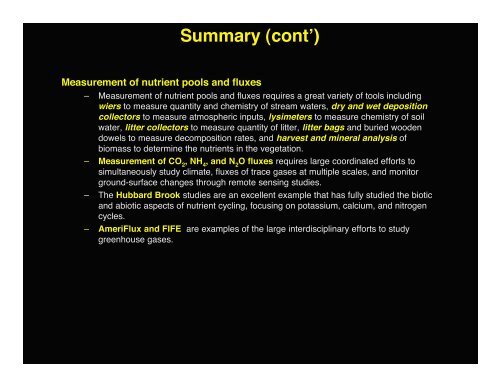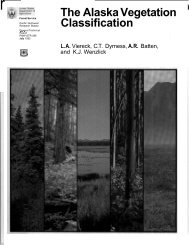Lesson 32 Mineral Cycling - Alaska Geobotany Center
Lesson 32 Mineral Cycling - Alaska Geobotany Center
Lesson 32 Mineral Cycling - Alaska Geobotany Center
Create successful ePaper yourself
Turn your PDF publications into a flip-book with our unique Google optimized e-Paper software.
Summary (cont )<br />
Measurement of nutrient pools and fluxes<br />
– Measurement of nutrient pools and fluxes requires a great variety of tools including<br />
wiers to measure quantity and chemistry of stream waters, dry and wet deposition<br />
collectors to measure atmospheric inputs, lysimeters to measure chemistry of soil<br />
water, litter collectors to measure quantity of litter, litter bags and buried wooden<br />
dowels to measure decomposition rates, and harvest and mineral analysis of<br />
biomass to determine the nutrients in the vegetation.<br />
– Measurement of CO 2<br />
, NH 4<br />
, and N 2<br />
O fluxes requires large coordinated efforts to<br />
simultaneously study climate, fluxes of trace gases at multiple scales, and monitor<br />
ground-surface changes through remote sensing studies.<br />
– The Hubbard Brook studies are an excellent example that has fully studied the biotic<br />
and abiotic aspects of nutrient cycling, focusing on potassium, calcium, and nitrogen<br />
cycles.<br />
– AmeriFlux and FIFE are examples of the large interdisciplinary efforts to study<br />
greenhouse gases.
















